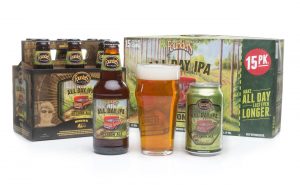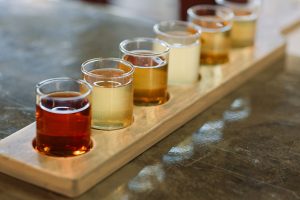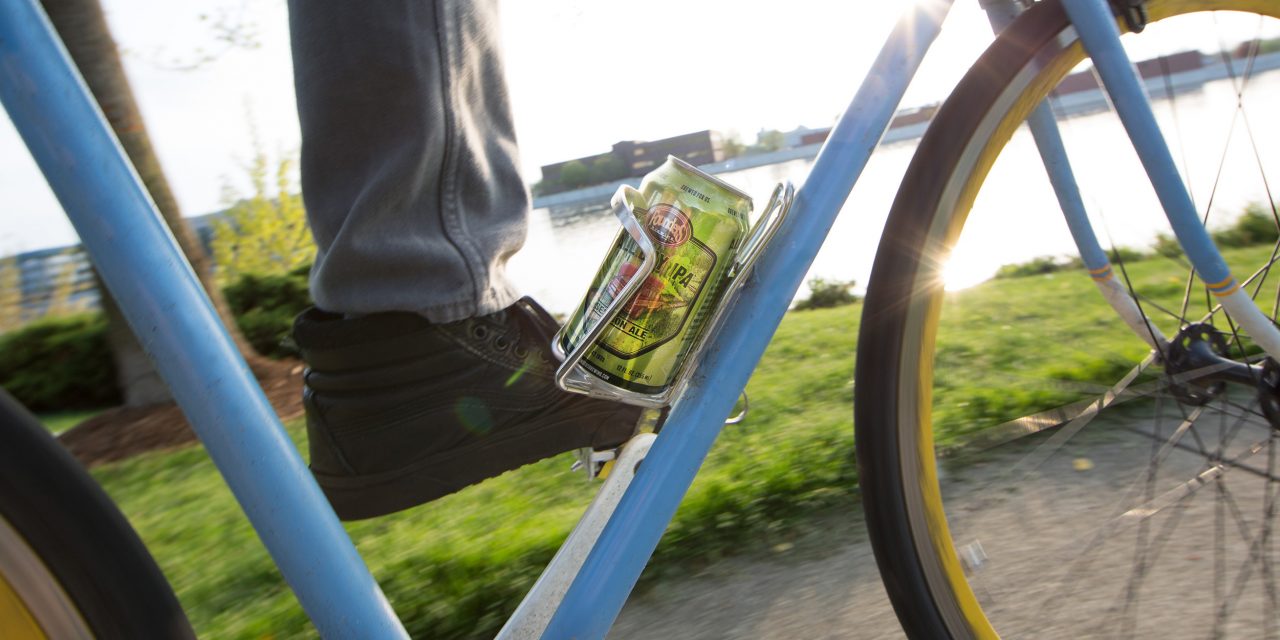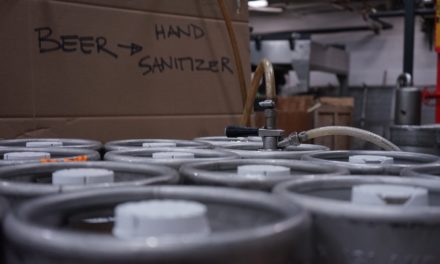Let’s start with the obvious: The craft beer industry has been pretty successful at engaging millennials (those born in the early 1980s through the early 2000s) on a variety of fronts. At last year’s Craft Brewers Conference in Philadelphia, Mike Kallenberger and Lindsay Kunkle’s talk, “How to Build a Craft Beer Drinker,” included a recent finding that millennials accounted for around 57 percent of weekly craft beer drinkers. (By comparison, Gen Xers came in at 24 percent, baby boomers at 17 percent, and matures at 2 percent.)

Lindsay Kunkle was part of the team that discussed “How to Build a Craft Beer Drinker” at the 2016 Craft Brewers Conference
Most of the above talk’s findings were based on the national 2015 Yankelovich Monitor Survey, and Kunkle touches on three elements that repeatedly have been found to be helpful in attracting what’s become the country’s largest consumer group: brands that are authentic, value-driven, and deliver unique new experiences.
The 2016 Trend Insight Report by FONA International (which examines millennial trends across various alcohol beverage industries—and is worth a look) is based heavily on research from the Mintel Group and touches upon similar trends: “Millennials value experience and authenticity. They mistrust most advertising but are more open to it if it’s viewed online. And when it comes to making beer, wine, and spirit decisions, they rely on online marketing, blog recommendations, in-store tastings, and attending food and drink festivals.
Trending Flavors
Mike Kallenberger of Tropos Brand Consulting (the other CBC speaker mentioned above), summarizes a link between craft beer and millennials as follows: “I’m convinced there’s a set of millennial core values that really are reflected in craft beer and craft brewers and what they’re trying to do.”
He also frames the millennial discussion as being more about an ascendent set of values within culture as a whole as opposed to being limited to an age group. “Millennials are the first generation to grow up when that set of values reached critical mass,” Kallenberger explains. “But plenty of people among Gen Xers and boomers share those values.”

“All of a sudden, there was a generation that had grown up only knowing craft beer.” —Dave Engbers, Founders Brewing Co.
The FONA report goes into some further detail on millennial affinities, including a tendency toward healthier/lower ABV options, as evidenced by the recent rise of sub-5 percent “session” beers (most typically, and not too surprisingly, in the form of session IPAs). The report also emphasizes millennials’ increased tendencies to consume beer in social settings rather than at home, counter to earlier generations—and lower-ABV options can definitely help prolong social drinking experiences.
The FONA report goes so far as to single out trending flavor profiles for different beverage categories, with honey appearing across multiple categories, along with spice, citrus, fruits of all manner, coconut, and ginger. We’re seeing some new honey beers, sure. And that fruit and citrus angle—tangerine IPAs to blackberry gose to hazy IPAs—is definitely getting attention from consumers and brewers right now. That said, such tides can shift very quickly.
Ahead of the Curve
Founders Brewing Co. in Grand Rapids, Mich., one of the very first breweries to make a session IPA on a large scale, did so in response to a newer consumer in its taproom. Dave Engbers, co-founder and president, recalls, “In 2009, shortly after we moved into our new facility, we started realizing there was a much larger craft-beer audience emerging. All of a sudden, there was a generation that had grown up only knowing craft beer.”
 Tweaking one of its house beers (Solid Gold) over a period of years until arriving at a final version, called All Day IPA, Founders—which had never had a high-volume seller before—did a limited release of the beer in 2012, then a full release in February 2013; it quickly became their bestseller. The entirely-unconventional-for-craft-beer 15-packs of All Day IPA were launched in spring 2014, and this sub-5 percent beer, showing an image of a wood-paneled car with a canoe on top, traveling down a lush country dirt road, has become more than 50 percent of Founders’ volume. And those 15-packs definitely prolong the abovementioned social drinking.
Tweaking one of its house beers (Solid Gold) over a period of years until arriving at a final version, called All Day IPA, Founders—which had never had a high-volume seller before—did a limited release of the beer in 2012, then a full release in February 2013; it quickly became their bestseller. The entirely-unconventional-for-craft-beer 15-packs of All Day IPA were launched in spring 2014, and this sub-5 percent beer, showing an image of a wood-paneled car with a canoe on top, traveling down a lush country dirt road, has become more than 50 percent of Founders’ volume. And those 15-packs definitely prolong the abovementioned social drinking.

Tour de Fat
A crucial element for Founders was merging the wants of this emerging consumer with the company’s core brand—“Brewed For Us”—and crafting a beer that really does appeal to the beer geek and wider consumer alike. That’s hard lightning to bottle, and Engbers emphasizes the importance of balancing analytics with the company’s core values. “We do look at a lot of data. We look at the entire landscape of the industry, but we do things our own way.”
Kallenberger points to New Belgium Brewing Co.’s Tour de Fat as another very successful overlap of millennial values and the values of the brand—creating a carnival-style, multicity celebration highlighting “great beer, bikes, music, comedy, sustainability, and philanthropy,” according to the website. It’s being expanded to 33 cities this year.
“It taps into a value of play,” Kallenberger explains, “which is a big thing for the brand, and for millennials.”

“Where are they? Where are they getting their information? Where are they going to hang out? What events are they involved with? What’s important to them?” —Bryan Simpson, New Belgium Brewing
Bryan Simpson, New Belgium’s public relations director and an employee owner, explains the brewery has a field branding team of about a dozen employees who throw events in all its markets. “We’re doing a lot more research as to who our consumer is: Where are they? Where are they getting their information? Where are they going to hang out? What events are they involved with? What’s important to them?”
The brewery recently updated three of its existent IPA varieties under a new Voodoo Ranger lineup, with character-driven marketing and hop profiles that better reflect the Juicy Fruit-like focus they find drinkers are currently seeking (over the beers’ previous piney bitterness). “It’s ahead of forecast and selling extremely well,” remarks Simpson.
He singles out the experiential and digital realms as being two key components to New Belgium’s success with millennials—and that these things work in tandem. As he puts it, “making sure you’re speaking to that audience where they like to communicate.” Building a large digital platform has helped the brewery amplify what it’s doing with experiental marketing.
Generational Gap

“Really, I’m just trying to make things that I like and that I think people I know would like.” —Robert Cordtz, Sonoma Cider
As of December 2016, the United States passed the 5,000-brewery mark; Kallenberger notes the success of early “irreverent” brands like Dogfish Head Craft Brewery (Milton, De.) and Stone Brewing (Escondido, Calif.), but questions the rationale for newly opened spots with a common ethos. “They’re going to have a hard time differentiating themselves.”
Sonoma Cider in Healdsburg, Calif., has managed to distinguish its products in an increasingly competitive cider market with releases like bourbon-flavored Anvil and sarsaparilla-vanilla Washboard, balanced by traditional apple and pear varieties in their core lineup.
The cidery was started by father-and-son team David and Robert Cordtz, with 32-year-old Robert spearheading many of the pair’s more outlandish ciders (including Anvil and Washboard). He emphasizes that he and his father (in his early 60s) are wholly aware there’s a generational gap at play.
“[My dad] has more of a traditional single-varietal, barrel-aged approach, which is similar to a winemaker’s approach,” Robert reflects. “I like to just do weird sh** and have that Funky Buddha [Brewery] approach, where there are no rules, just do whatever sounds fun. We take it both directions at the same time.”
 Rather than specifically targeting millennials, Robert says he’s simply making products he’s interested in—while slowly bringing his father around to his way of thinking. “As time has gone on, [dad] started to realize that [the less traditional ciders] do really well, and he started trusting me a little bit more. That’s how I got to the breakfast cereal flavors.” Sonoma Cider’s new release, The Jax, was inspired by Robert’s childhood love of cereal (notably Apple Jacks); it includes toasted buckwheat, honey, cinnamon, fresh apple juice, and dry cider. It’s sold “crazy well,” he says, adding, “We sell cases-to-go in the taproom, and we usually bring over about 20 of [The Jax] when we bring over three of each of the others.”
Rather than specifically targeting millennials, Robert says he’s simply making products he’s interested in—while slowly bringing his father around to his way of thinking. “As time has gone on, [dad] started to realize that [the less traditional ciders] do really well, and he started trusting me a little bit more. That’s how I got to the breakfast cereal flavors.” Sonoma Cider’s new release, The Jax, was inspired by Robert’s childhood love of cereal (notably Apple Jacks); it includes toasted buckwheat, honey, cinnamon, fresh apple juice, and dry cider. It’s sold “crazy well,” he says, adding, “We sell cases-to-go in the taproom, and we usually bring over about 20 of [The Jax] when we bring over three of each of the others.”
Asked about working with market data, Cordtz thinks it often doesn’t arrive fast enough. “To me it seems kind of like, by the time you get it, it’s too late. Really, I’m just trying to make things that I like and that I think people I know would like.”
(For ideas about what your beer-loving friends would like, check out this Groomstand blog: “5 Gifts Only a Beer Lover Will Love“)
Competing Options
Millennials’ interest in other beverage segments remains very much linked and in flux, with hard sodas seeing an especially large uptick in the past couple of years. Mintel Global Drinks Analyst Jonny Forsyth reported in 2016 that, “More than two in five U.S. drinkers aged 22-plus are interested in trying products with alcoholic soda flavors such as root beer and ginger ale, with millennials and Hispanics displaying increased interest.”
He added, “Perhaps due to the recent U.S. recession, both millennials and Gen Xers appear especially prone to longing for the past.” While Forsyth questioned whether this massive and sudden interest in hard sodas would last, given the usual volatility of the flavored malt beverage market, he acknowledged, “It will be interesting to see whether nostalgic-themed marketing and heavily targeting millennials and Gen Xers will help hard sodas avoid such a fate.”
Kallenberger, in assessing some of the larger millennial themes, suggests some of these very human trends—the nostalgia, the playfulness, the desire for new experiences, but also values, authenticity, and community—speak of a generation that’s (consciously or unconsciously) attempting to fuse some of the very best parts of adulthood and childhood.
But be wary of predicting anything will stay the same for very long these days. Kallenberger hints the tides could shift again very soon: “The post-millennial generation is about to turn 21.”











